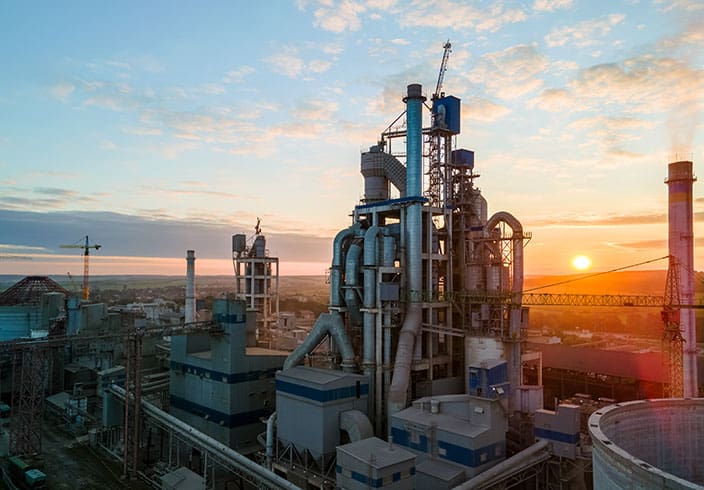By 2050, the EU should have achieved climate neutrality. Through a multitude of laws and regulations, politicians want to motivate business and society to act. Many central questions are at stake: Will the EU succeed in reducing emissions by 55 per cent compared to 1990 in the next seven years? What technologies and measures are needed to achieve the climate goals? Above all, with regard to the energy and heat transition in resource-intensive industry, so that the conversion to a climate-neutral industry can succeed. An industry that, despite strong efforts for environmental protection and sustainability, still finds it difficult to do without fossil raw materials and energy sources.
These are the challenges companies face when implementing
This much is certain: with a view to the ambitious goal of climate neutrality, there is no way around an energy and heat turnaround in industry. After all, industry accounted for a significant share of total energy consumption – the majority of which was needed to provide heating and cooling. Many industrial processes have an enormously high heat demand. Accordingly, a conversion of the power and heat supply to renewable energies and thermal storage solutions does indeed hold great opportunities for the companies involved – especially in view of the attractive subsidy measures and the independence from fossil energy sources as well as their conflict-ridden supplier nations. However, the changeover also brings challenges. In many places, the prerequisites must be created to convert tried-and-tested processes and technologies to the state of the art. Due to the volatility of renewable energy sources, companies with a high energy demand in particular are concerned about security of supply. How can it be ensured that there is always enough green energy available for industrial energy and heat supply? And can the demand be met in an economically viable way and scaled accordingly?
Technologies and measures to increase the climate neutrality of industries
With a focus on sustainable decarbonisation of our industry, various technologies and measures are currently being intensively researched and tested. Some have already reached market maturity and offer great potential, especially for energy-intensive industries that rely on high temperatures. In addition to the growing electrification of industrial processes, these include above all processes that keep environmentally harmful CO2 out of the atmosphere, as well as digital technologies that record energy consumption as precisely as possible and thus make it scalable, and storage solutions that make the feed-in, storage and provision of regeneratively generated energy more flexible and economically attractive for the companies involved.
1. Carbon Capture and Storage (CCS)
Carbon capture and storage (CCS) is the long-term, underground storage of carbon dioxide – whether on land or underground in the ocean. According to information from the German Federal Environment Agency (Bundesumweltamt), the CO2 to be stored can come either from fossil energy supply plants, from industrial plants or from the use of biomass for energy production. In the context of CCS, long-term storage of the carbon dioxide is possible in exploited gas or oil deposits, in saline aquifers or in the ocean subsurface. As part of a sustainable climate strategy, CCS is well respected, but not without controversy. According to experts, in the unlikely, but quite possible, event of leakage from the storage facilities, there may be harmful effects on groundwater and soil.
2. Increase energy efficiency through process optimisation
It is a fact that sustainable process optimisation makes the greatest contribution to the long-term decarbonisation of industry. Many companies are looking intensively at their processes with internal and external expertise and are designing strategies on how, for example, a change of energy sources and electrification of formerly fossil processes can strengthen the environmental balance and at the same time be economically efficient, profitable and attractive. In particular, the provision and recycling of process heat using the latest energy storage technologies has great potential against this background.
3. Digitalisation for a climate-neutral industry
Digitalisation is also seen as a central catalyst with regard to a climate-neutral industry. With the help of state-of-the-art technologies and applications, including cloud solutions, big data, AI and machine learning, many processes should be able to be optimised sustainably. Digital methods such as the digital twin – a simulation application that is often used instead of costly and energy-intensive prototyping – can save energy sustainably. Predictive maintenance based on predictions by AI optimises the operationality and service life of machines. Energy consumption can also be made optimally measurable, plannable and thus scalable thanks to various digital tools and processes.
4. Storing energy with thermal batteries & co.
In view of the growing electrification and decarbonisation of process heat, thermal energy storage solutions such as thermal batteries are seen as having high potential on the way to a climate-neutral industry. One technology that has long since reached market maturity and is already being used in various sectors is the innovative ThermalBattery™ from ENERGYNEST. The highlight: The storage solution can be charged with regeneratively generated energy at economically favourable times, stores it inside the battery in a special concrete called HEATCRETE® and can release it again flexibly as needed in the form of heat and steam. A major advantage: the solution functions in a modular way according to a plug-and-use principle and can be provided completely without acquisition and maintenance costs at the customer’s request.
Synergies between climate-neutral industry and renewable energies
A climate-neutral industry is unthinkable without an increased focus on renewable energies. After all, climate neutrality presupposes a sustainable shift away from fossil raw materials and offers the best prerequisite for making optimal use of the natural and sustainable resources of sun and wind – without CO2 emissions that cause great damage in the atmosphere. Many technologies and processes dealing with the industrial use of green power also conclude that a sustainable energy and heat transition in our industry also offers significant financial benefits – for example by making the electricity market more flexible, using and trading surplus power and recycling waste heat.
With regard to the urgently needed flexibilisation, energy storage solutions such as the ThermalBattery™ play a very important role, as they are very good at compensating for the temporary imbalance between supply and demand for regeneratively generated energy. At the same time, appropriate storage solutions enable the using companies to integrate their own renewable energy generation plants into the production processes. Thus, the option to store surplus energy during the day and use it at night contributes significantly to the decarbonisation of production and at the same time makes the company independent of fluctuating electricity market prices and availability. The resulting synergies benefit the environment and industry alike.
Future prospects for a climate-neutral industry
Initiatives to decarbonise our industry are many and varied – and continuous development and testing is underway. This also benefits the companies themselves, for whom the use of green energy and the heat generated from it provides valuable image and competitive advantages, especially in view of the growing relevance of ESG criteria.



